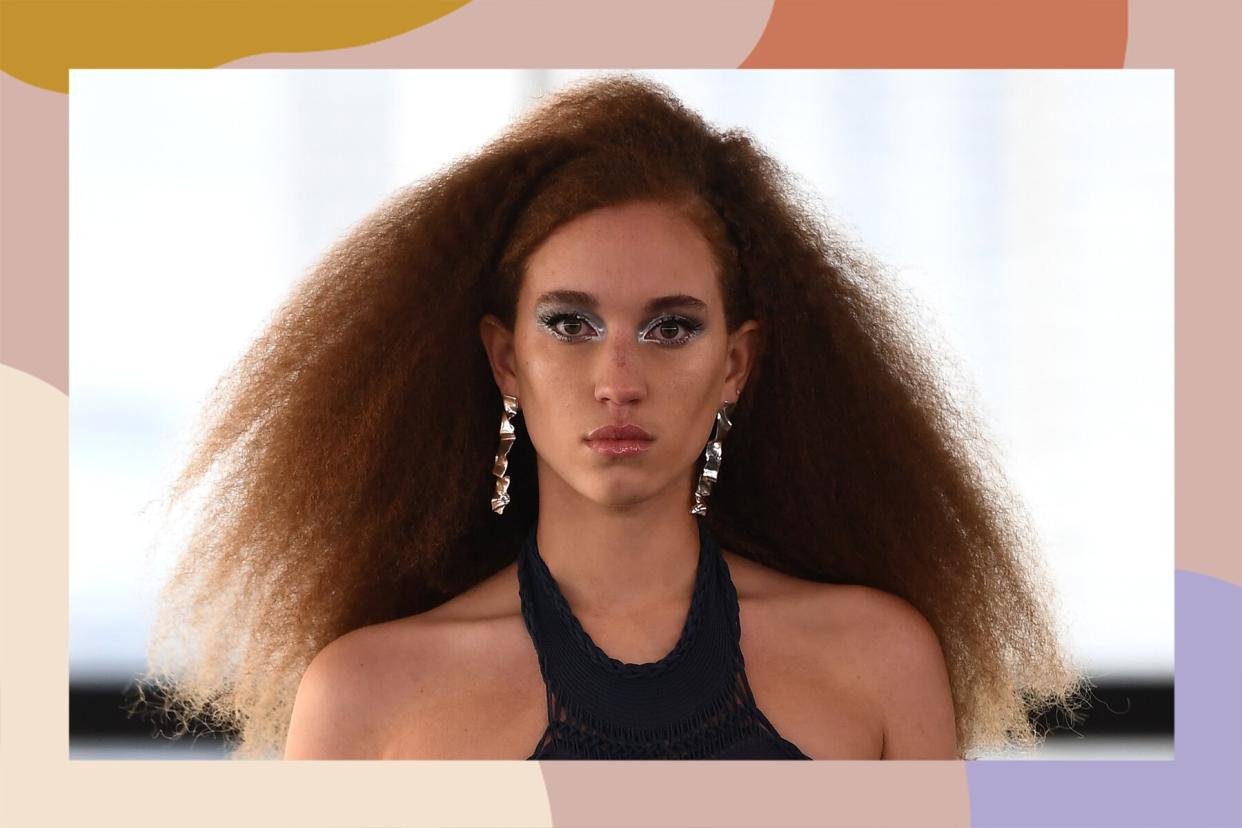Crimped Hair is Back and Hotter Than Ever, But is it Cultural Appropriation?

Jeff Spicer, Getty Images
We all know that trends come and go. You probably thought '90s frosted lips and denim overalls were gone for good only to find out that they're back and trendy as ever, so never say never. (OK, maybe low-rise jeans are where we draw the line). Now, the crimped hairstyles that were so popular in the '80s, '90s, and early 2000s have come back in a big way in recent months. Everyone from Lizzo to Elizabeth Olsen have hopped onto the crimping train, and it shows no signs of stopping—but should it?
In 2019, when Vogue Runway insinuated in a tweet that Kim Kardashian was single-handedly reintroducing the trend, people were quick to point out that Black women had been wearing crimped styles for years before. Beyoncé, Nicki Minaj, Rihanna, and Janet Jackson all famously wore crimped hair throughout the 2010s (as did countless non-famous Black women), but it wasn't until Kardashian—a non-Black woman with a history of appropriating Black culture—did the same that crimping was hailed as the style to watch by mainstream media.
Kim Kardashian West is bringing crimped hair back in a big way. https://t.co/iV1vWoCP0J pic.twitter.com/x23VEK78wr
— Vogue Runway (@VogueRunway) March 15, 2019
This incident is far from isolated, inscribing itself in a long and frustrating tradition of white and non-Black people adopting styles that Black people have been perfecting for years, only to receive all the credit for it. Bantu braids are one example of this tradition—they're traditionally Black, and when non-white people wear them without acknowledging, appreciating, and supporting Black culture, it's incredibly insensitive. (Remember when Adele wore them at a festival? Cringe…)
Black women still face workplace discrimination for wearing their natural hair, so for a non-Black person to copy a Black hairstyle without understanding its history and appreciating its roots is not okay. Even when it's done with the best intentions, it's still not okay. "Black people have historically been discriminated against for wearing traditionally Black hairstyles, and we can still see that today," explains anti-racist educator Marie Beecham. While a white person may be praised for wearing crimped hair, for example, it could be deemed as unprofessional if a Black person did it. (In fact, a 2019 study found that Black women were 1.5 times more likely to be sent home from the workplace because of their hair.)
“For me, a helpful framework is thinking of cultural appropriation like plagiarism. When you have an understanding of context and you properly cite your sources out of respect for the original work, it’s no longer careless plagiarism. I think that we can use the same recipe for stepping away from cultural appropriation and into cultural appreciation.”
—Marie Beecham
When it comes to appropriation, crimped hair fits in more of a gray area. The modern crimping iron was first invented by stylist Geri Cusenza for Barbra Streisand's Butterfly album in 1972. Crimped hair quickly became Streisand's signature look, and Cusenza's iron sold like hotcakes. The style endured through the decades, seen on the likes of Demi Moore and Alyssa Milano in the '80s, and Melissa Joan Hart and Tyra Banks in the '90s. Many of you will remember crimps as the style to have if you wanted to be cool in the 2000s—we all wanted to copy the styles of Christina Aguilera, Lizzie McGuire, or Britney Spears. However, as we moved out of the '90s and early 2000s, it was mainly Black women who wore their hair in crimped styles as non-white people moved onto other trends.
she did what???? pic.twitter.com/ltps6ieJAE
— 𝒎𝒊𝒄𝒂𝒉 ⭒ (@MlCAHNICOLE) March 15, 2019
Crimped hairstyles were spotted at the most recent London Fashion Week on the virtual runway shows for Molly Goddard and Mark Fast, and models also wore them back in the fall at Armani in Milan and Vivienne Westwood in London. L'Officiel recently called it one of the retro styles that's decidedly in for 2021, and celebrity hairstylist Jen Atkin also forecasted the trend in a December interview with Vogue. While this may be so, it's still important to understand the roots of the trend.
"I’m not inclined to say that a specific hairstyle is off-limits for any group. [However,] I am inclined to say that before you emulate any element of a culture that isn’t yours, learn about the history and the significance. By starting with learning, you’ll be equipped to make an informed decision about whether partaking would be respectful or insensitive.”
—Marie Beechman
Since crimping doesn't originate from Black culture, it might feel okay for anyone to have fun with the hairstyle. However, to imply that the trend disappeared and was brought back by a non-Black person is inaccurate, as there are so many Black women who have been sporting the texturized style for decades. When they wore the style it was mainly ignored by mainstream media, so to suggest something can only be trendy if a non-Black person wears it feeds systemic racism, and we're not having it.
Beecham is happy for anyone to rock some crimps as long as they feel comfortable doing so and give credit where it's due. Crimped hairstyles are fun, loud, and statement-making, and they can really tap into our nostalgia, too. "The actual crimping iron was invented the same year I was born," says Lyndell Mansfield, a London-based hairstylist at Of Substance. "I grew up with it. I saw it on housewives, punks, prom queens, and my mum."

